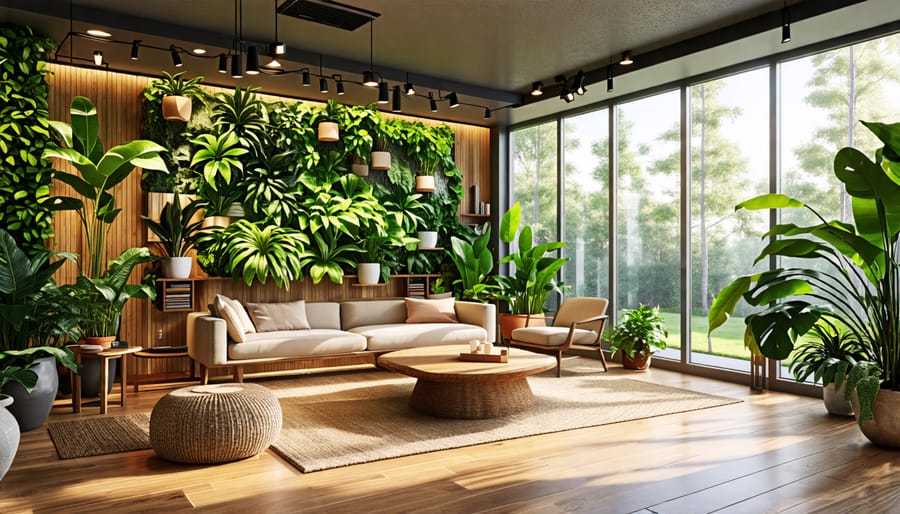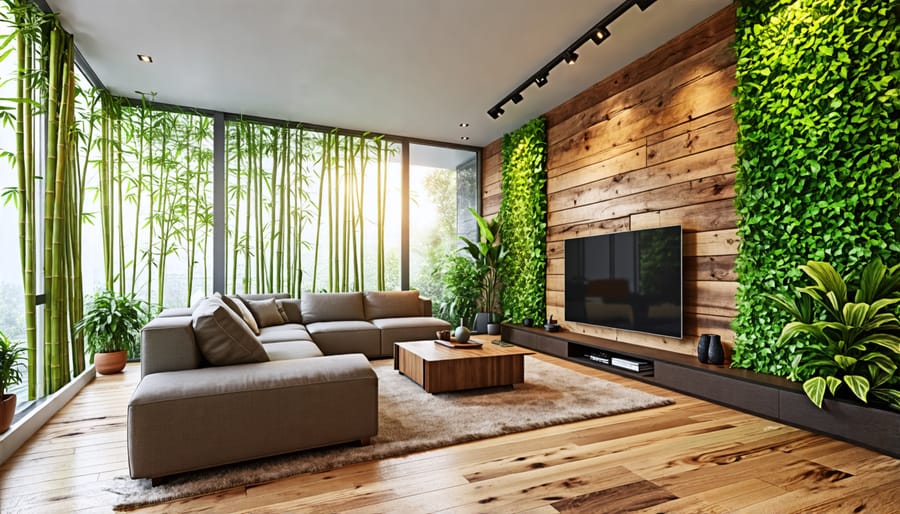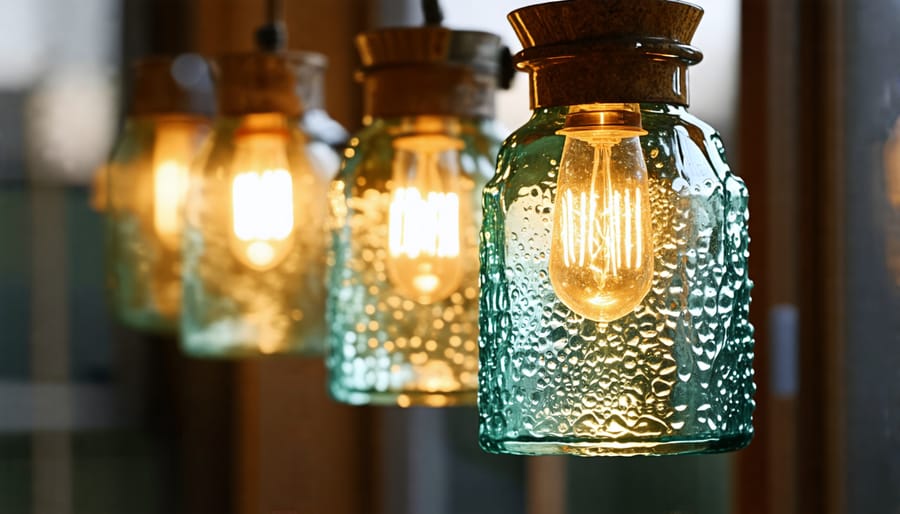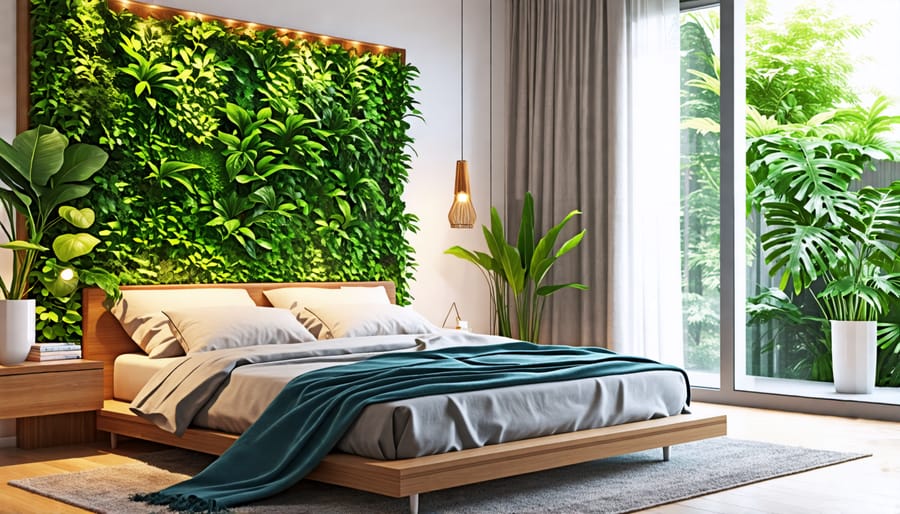
10 Inspiring Sustainable Interior Design Examples to Green Your Space
Choose eco-friendly materials like bamboo, cork, or reclaimed wood for flooring, furniture, and accents. Incorporate energy-efficient lighting solutions, such as LED bulbs or natural daylight optimization, to reduce your carbon footprint. Opt for low-VOC paints, stains, and finishes to improve indoor air quality and minimize harmful emissions. Integrate biophilic design elements, including living walls, potted plants, and nature-inspired patterns, to create a healthier, more sustainable living space.
Sustainable Material Selections

Reclaimed Wood
Reclaimed wood is a fantastic sustainable material to incorporate into your interior design. Salvaged from old buildings, barns, and other structures, it brings a unique character and rustic charm to any space. For flooring, consider installing reclaimed hardwood planks, which are not only environmentally friendly but also durable and timeless. Reclaimed wood can also be used to create stunning statement furniture pieces, such as a dining table crafted from an old barn door or a bookshelf made from weathered wood pallets. These restoration projects give new life to discarded materials while adding a touch of history to your home. Smaller accents like reclaimed wood picture frames, mirror borders, or wall art can also make a big impact without overwhelming the space. By choosing reclaimed wood, you’re not only reducing waste but also bringing a one-of-a-kind, eco-chic element to your interior design.
Bamboo and Cork
Bamboo and cork are two rapidly renewable materials that make excellent choices for sustainable interior design. Bamboo is a fast-growing grass that can be harvested every 3-5 years without damaging the plant or surrounding ecosystem. It’s incredibly versatile and can be used for flooring, furniture, and decor. Cork is another eco-friendly option, harvested from the bark of cork oak trees without harming the tree itself. It’s naturally insulating, water-resistant, and soft underfoot, making it perfect for flooring or wall tiles. Both bamboo and cork are durable, attractive, and can add warmth and texture to your space. Incorporate these materials into your home through eco-friendly DIY projects like a bamboo room divider or cork bulletin board. By choosing rapidly renewable materials, you can create a beautiful, sustainable living space that’s gentle on the planet.
Recycled Metal and Glass
Recycled metal and glass can be transformed into stunning, eco-friendly statement pieces for your home. Salvaged steel pipes can be repurposed into unique table bases, paired with reclaimed wood tops for an industrial-chic look. Vintage glass bottles can be upcycled into charming pendant lights, casting a warm glow and adding character to any room. Reclaimed metal signs can be given new life as wall art, bringing a touch of nostalgia and history to your space.
For a truly one-of-a-kind piece, consider commissioning a local artisan to create a custom sculpture or furniture item using recycled metal and glass. A talented metalworker can craft a beautiful headboard from old car parts, while a skilled glassblower can transform recycled glass into a mesmerizing centerpiece. By incorporating these recycled elements into your interior design, you not only reduce waste but also add unique, conversation-starting pieces to your home.

Energy-Efficient Lighting
Energy-efficient lighting is a key component of sustainable interior design. LED bulbs are a popular choice, as they consume significantly less energy than traditional incandescent bulbs while lasting much longer. When selecting LED lights, look for options with warm color temperatures to create a cozy, inviting atmosphere in your living spaces.
In addition to LEDs, incorporating natural light is another eco-friendly lighting strategy. Consider installing skylights or solar tubes to bring daylight into central areas of your home, reducing the need for artificial lighting during the day. Large windows and glass doors can also help illuminate your space, but be sure to choose energy-efficient options with low-E coatings to minimize heat transfer.
When arranging your furniture, prioritize placing seating areas and workspaces near windows to take advantage of natural light. Use sheer curtains or adjustable blinds to control glare and heat gain while still allowing daylight to enter.
For a creative DIY lighting project, try repurposing old jars or bottles into unique pendant lights. Simply add an LED bulb and a decorative cord, and you’ll have a one-of-a-kind, eco-friendly light fixture.
Finally, don’t forget the importance of lighting controls. Installing dimmer switches, motion sensors, and timers can help you manage your energy consumption by ensuring lights are only on when needed. By combining energy-efficient bulbs with smart lighting strategies, you can create a beautifully illuminated space that’s both sustainable and inviting.
Living Walls and Biophilic Elements
Living walls and indoor gardens bring the beauty and benefits of nature indoors, creating a serene, refreshing atmosphere in your living space. Imagine a lush vertical garden greeting you as you enter your home, purifying the air and providing a stunning focal point. You can create a living wall using modular systems, hydroponics, or even upcycled pallets and containers. Fill them with a variety of plants suited to indoor conditions, such as pothos, philodendron, snake plants, and ferns.
For a smaller-scale option, incorporate indoor gardens into your design. A kitchen herb garden not only adds a fresh, vibrant touch but also provides you with fresh ingredients at your fingertips. Terrariums make lovely decorative accents, creating miniature ecosystems in glass containers. They’re perfect for small spaces and require minimal maintenance.
Biophilic design elements draw inspiration from nature, bringing organic shapes, natural materials, and soothing colors into your interior. Incorporate wood, stone, and organic textiles to create a sense of connection with the outdoors. Choose earthy colors like greens, blues, and warm neutrals to evoke a calm, grounded feel.
Embrace nature-inspired patterns, such as botanical prints, leaf motifs, and organic shapes, in your fabrics, wallpaper, and artwork. Create a feature wall with a nature-themed mural or hang a series of botanical prints to bring the beauty of the outdoors inside.
Maximize natural light by keeping windows unobstructed and using sheer curtains or light-filtering blinds. Install skylights or solar tubes to bring daylight into darker areas of your home. Combine these biophilic elements with your living walls and indoor gardens to create a harmonious, nature-inspired space that promotes well-being and sustainability.

Multifunctional and Space-Saving Solutions
Multifunctional and space-saving solutions are key to sustainable interior design. Modular furniture pieces that serve multiple purposes can greatly reduce the overall footprint of your living space. For example, a sofa bed or a storage ottoman can provide both seating and sleeping or storage options, eliminating the need for separate pieces. Similarly, a dining table that can be extended or folded down when not in use can help maximize floor space.
Dual-purpose furniture is another smart choice for eco-friendly interiors. A bookshelf with a built-in desk can serve as both storage and a workspace, perfect for small apartments or to Improve Your Home Office. A coffee table with hidden storage compartments can keep clutter at bay while providing a surface for drinks and decor.
Efficient layouts are also crucial for sustainable design. Consider an open floor plan that allows for flexible use of space, with furniture arrangement defining different functional zones. Use room dividers, such as curtains or sliding panels, to create temporary partitions as needed. Vertical space should also be utilized, with tall shelving units or hanging storage baskets to keep items off the floor.
Investing in high-quality, durable furniture pieces that can adapt to changing needs over time is another sustainable strategy. Look for items made from eco-friendly materials, such as bamboo, reclaimed wood, or recycled metal. By choosing versatile, long-lasting pieces, you can reduce waste and minimize the need for frequent replacements.
Ultimately, the key to sustainable interior design is to be intentional with your choices, opting for multifunctional, space-efficient solutions that serve your needs while minimizing environmental impact. By thinking creatively and embracing dual-purpose design, you can create a stylish, comfortable home that’s also good for the planet.
Non-Toxic Paints and Finishes
Using low-VOC, eco-friendly paints and natural finishes is a simple yet effective way to create a healthier, more sustainable living space. Traditional paints often contain volatile organic compounds (VOCs) that emit harmful gases, contributing to indoor air pollution and potential health issues. In contrast, low-VOC and zero-VOC paints significantly reduce these emissions, ensuring a safer environment for you and your family. When selecting paints, look for brands that offer water-based, non-toxic formulas with minimal odor.
In addition to paints, consider using natural finishes such as beeswax, linseed oil, or milk paint for woodwork and furniture. These eco-friendly alternatives provide beautiful, durable results without the need for harsh chemicals. They also allow the natural beauty of the wood grain to shine through, adding warmth and character to your interior design. When choosing fabrics for upholstery and window treatments, opt for pet-friendly fabrics that are also sustainable, such as organic cotton, bamboo, or recycled polyester. By incorporating non-toxic paints and finishes throughout your home, you’ll create a healthier, more eco-conscious living space that reflects your commitment to sustainability.
